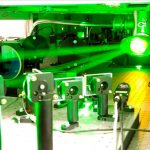The research and development (R&D) activity in the Intense laser irradiation laboratory (ILIL) takes place within the themes related to the use of power lasers:
- Miniature accelerators of high energy particles with fully optical technology
- Optical spectroscopy, X and gamma for elementary and structural analysis of materials
- Micro-processing of materials with ultrashort lasers
- Synthesis of nanoparticles/colloids with laser ablation in a liquid environment
- Development of X-ray sources by laser-plasmas interaction
- Damage test of optical/electronic material by intense e.m. radiation
- Advanced technologies for new laser sources and plasma diagnostics
 The ILIL carries out research on the interaction between radiation and matter at very high intensity and studies its applications to energy, life and materials sciences. The Laboratory participates in the European projects for laser fusion, the development of miniature particle accelerators (ions, electrons) with lasers, the development of sources and diagnostics of X and gamma radiation from laser-plasmas, to R&D activities of advanced technologies for new laser sources and plasma diagnostics. The laboratory has skills in micro-processing of materials with ultrashort lasers and synthesis of nanoparticles in a colloid environment through laser ablation in liquid-solvent. Finally, the laboratory has spectroscopy skills in the X-UV-visible range to be used as diagnostic tool. The Laboratory is equipped with advanced ultrashort pulse laser systems and a complete range of sensors for the study of plasma radiation from infrared to gamma rays.
The ILIL carries out research on the interaction between radiation and matter at very high intensity and studies its applications to energy, life and materials sciences. The Laboratory participates in the European projects for laser fusion, the development of miniature particle accelerators (ions, electrons) with lasers, the development of sources and diagnostics of X and gamma radiation from laser-plasmas, to R&D activities of advanced technologies for new laser sources and plasma diagnostics. The laboratory has skills in micro-processing of materials with ultrashort lasers and synthesis of nanoparticles in a colloid environment through laser ablation in liquid-solvent. Finally, the laboratory has spectroscopy skills in the X-UV-visible range to be used as diagnostic tool. The Laboratory is equipped with advanced ultrashort pulse laser systems and a complete range of sensors for the study of plasma radiation from infrared to gamma rays.
In these areas, technology transfer takes place both through specific funded projects and through direct collaboration with private companies.
APPLICATION SECTORS
Applications of industrial interest are the elementary and structural characterization of materials through X-ray spectroscopy, the development of micro/nanotechnologies for the processing of materials and the synthesis of colloids with “green” methods, and high intensity photonics (materials, damage thresholds, sources, sensors).
POSSIBLE COLLABORATION THEMES WITH COMPANIES
 Synthesis of nanoparticles in aqueous solution e.g. Au, Ag and core-shell sensors based on Surface Enhanced Raman Scattering (SERS) for monitoring molecules (explosives, toxic substances, etc.); Pd and Pt to be used as catalysts; photoluminescent bio-compatible Si nanoparticle; magnetic nanoparticles.
Synthesis of nanoparticles in aqueous solution e.g. Au, Ag and core-shell sensors based on Surface Enhanced Raman Scattering (SERS) for monitoring molecules (explosives, toxic substances, etc.); Pd and Pt to be used as catalysts; photoluminescent bio-compatible Si nanoparticle; magnetic nanoparticles.- Development of spectroscopic sensors for elementary or structural analysis of materials also applicable to process or quality analysis on-line or for waste sorting and recycling.
- Test of optical and electronic material subject to high electromagnetic peak intensity and ionizing radiation (e.g. electronics of satellites exposed to solar wind).
- High stability and sensitivity interferometric sensors applicable to on-line density monitoring in plasmas and gaseous systems even in industrial environments.
The main technology transfer activities are:
- LaserPIXE project (2018-2020). Design and development of a compact system for elemental analysis using the PIXE (Particle Induced X-ray Emission) technique using a laser-plasma proton source with energy up to 3 MeV. The project partners are: CNR-INO (Coordinator), Institute of Clinical Physiology of the CNR, the Florence section of the National Institute of Nuclear Physics, and the private company Vacuum Components and Systems – VCS (Parma-Italy). The LaserPIXE project is funded under the program of the Tuscany Region POR FSE 2014 – 2020, Axis A Employment – Investment Priorities A.2 – Objective A.2.1 – Action A.2.1.7.
- Development and implementation of specific mechanical systems for vacuum equipment and precision opto-mechanical components with the companies VCS (parma-Italy) and VacuumFAB (Milan-Italy).
- Development and implementation of innovative optical diagnostics for the measurement of density in gaseous targets (vacuum pulsed jet and gas flow cells) for laser-plasma electron acceleration, in collaboration with SourceLAB
- Application of secondary radiation (X-rays and gamma), generated by electrons for bremsstrahlung in solid plates, for non-destructive analysis of materials in collaboration with SourceLAB.
